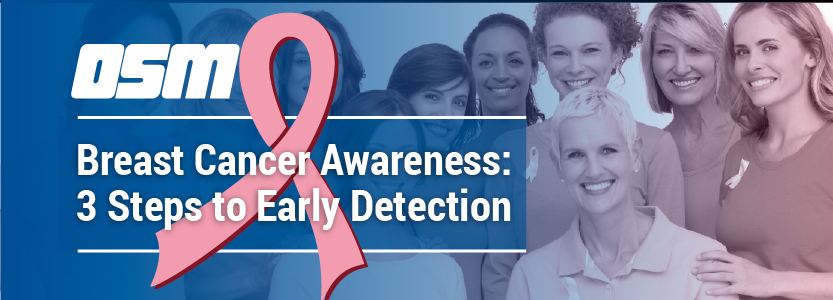Breast Cancer Awareness Month: 3 Steps to Early Detection
A bit of a departure from our typical post, we feel it is important to share important health information from a variety of resources on relevant topics beyond Orthopedics and bone health. In honor of National Breast Cancer Awareness Month, we’d like to share a few tips regarding early detection. There’s a good chance you or someone you know will be affected by this disease in their lifetime and early detection is the key to better outcomes. Please share this information with the women in your life.
From the National Breast Cancer Foundation
Help Detect Breast Cancer Earlier
This year, over 250,000 women will be diagnosed with breast cancer. The good news is that when breast cancer is detected early, it can be treated more successfully, increasing the chances for survival.
It is important to know the signs and symptoms of what could potentially be breast cancer. To help with this, National Breast Cancer Foundation has identified three steps you can take to be proactive about your breast health and help increase your chances of detecting breast cancer early.
This potentially life-saving information can be found in our free guide, 3 Steps to Early Detection. This free resource helps you answer three important questions:
- What should I look for if I examine my own breast?
- When should I see my doctor?
- When and how often should I get a mammogram?
From Atrio Health Plans
Three Steps to Early Detection
If there are eight American women in a room, one will develop invasive breast cancer over the course of her lifetime. In 2016 alone, it’s estimated that more than 246,000 new cases of invasive breast cancer will be diagnosed in the United States, along with 61,000 new cases of non-invasive breast cancer.
There also are incredibly encouraging breast-cancer statistics. For example, when breast cancer is detected early and in a localized stage, the five-year relative survival rate is 100 percent.
October is National Breast Cancer Awareness Month, and ATRIO Health Plans wants women to know that there are proactive steps they can take to detect breast cancer when it’s most treatable.
Step One: Be Aware of Potential Symptoms
Step one is being aware of potential breast-cancer symptoms. If you have any of the symptoms listed below, contact your healthcare provider promptly; chances are good that cancer is not the cause, but it’s worth your time to make an appointment if you notice:
- unusual nipple tenderness;
- changes in areola, nipple, or breast-skin texture, including enlarged pores, pitting, or reddened scaling;
- a lump in/near the breast or underarm;
- any unexplained change in the size or shape of a breast;
- swelling of the breast, particularly if on only one side;
- decrease in breast size, especially if just one breast is impacted;
- a nipple that has turned slightly inward or become inverted;
- Skin of the breast, areola, or nipple has become scaly, red, or swollen; also may have ridges or pitting resembling the skin of an orange;
- nipple discharges, particularly if they’re clear or bloody.
Step Two: Self-Exam
A woman’s next line of defense is performing monthly breast self-exams:
- In the shower – Move the pads of your fingers in a circular pattern from the outside to the center of each breast and armpit area. If a lump, thickening, or a hard knot is detected, contact your healthcare provider.
- In front of a mirror – Visually inspect your breasts, first with arms at your sides, then raised overhead. Keep an eye out for changes in breast as well as nipple shape, swelling, and skin dimpling; pay particular attention to changes occurring in just one breast.
- Lying down – With a pillow under your right shoulder and your right arm behind your head, move the finger pads on your left hand in a circular motion over the entirety of your right breast and armpit area; gently squeeze the nipple to test for discharge. Follow the same steps on your left breast.
Step Three: Mammogram and Clinical Exam
Women’s most effective early detection weapons are regularly scheduled mammogram screenings and clinical breast exams.
Mammograms often can uncover a breast lump before it can be felt. They also can point to potential abnormal cells. Current guidelines are:
- Women 40 and older should have mammograms every one or two years.
- Women who are younger than 40, and have breast-cancer-risk factors, should ask their healthcare professional how often they should have a mammogram.
A clinical breast exam is performed by a healthcare professional trained to recognize breast abnormalities. Most often, this exam is conducted by your primary care physician or gynecologist as part of an annual assessment.
October is the ideal month for women to empower themselves and take proactive steps to preserve their breast health.
Sources:
http://www.breastcancer.org/symptoms/understand_bc/statistics
http://www.nationalbreastcancer.org/early-detection-of-breast-cancer
http://www.nationalbreastcancer.org/breast-cancer-symptoms-and-signs
http://www.nationalbreastcancer.org/breast-self-exam
http://www.nationalbreastcancer.org/clinical-breast-exam
http://www.nationalbreastcancer.org/breast-cancer-stage-0-and-stage-1
The Orthopedic & Sports Medicine Center of Oregon is an award-winning, board-certified orthopedic group located in downtown Portland Oregon. We utilize both surgical and nonsurgical means to treat musculoskeletal trauma, spine diseases, sports injuries, degenerative diseases, infections, tumors and congenital disorders.
Our mission is to return our patients back to pain-free mobility and full strength as quickly and painlessly as possible using both surgical and non-surgical orthopedic procedures.
Our expert physicians provide leading-edge, comprehensive care in the diagnosis and treatment of orthopedic conditions, including total joint replacement and sports medicine. We apply the latest state-of-the-art techniques in order to return our patients to their active lifestyle.
If you’re looking for compassionate, expert orthopedic surgeons in Portland Oregon, contact OSM today.
Phone:
503-224-8399
Address
1515 NW 18th Ave, 3rd Floor
Portland, OR 97209
Hours
Monday–Friday
8:00am – 4:30pm




